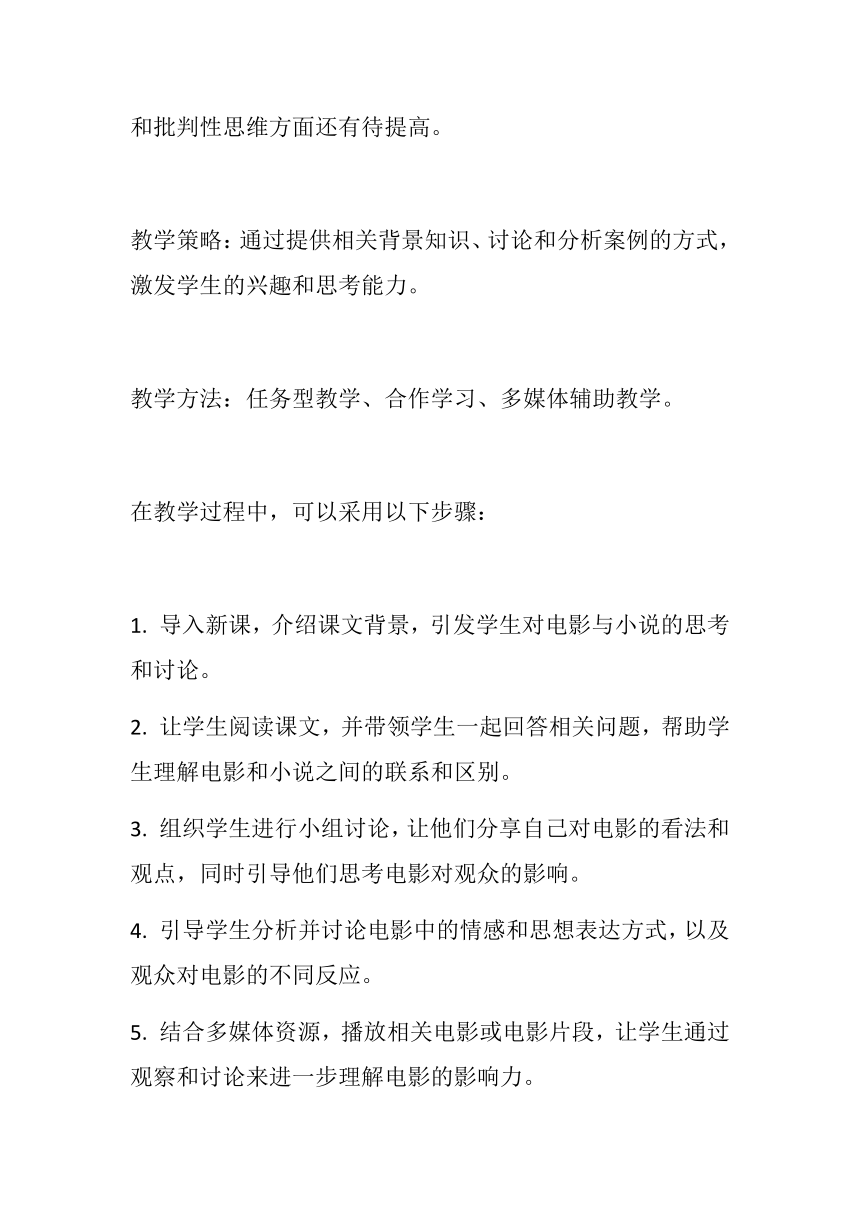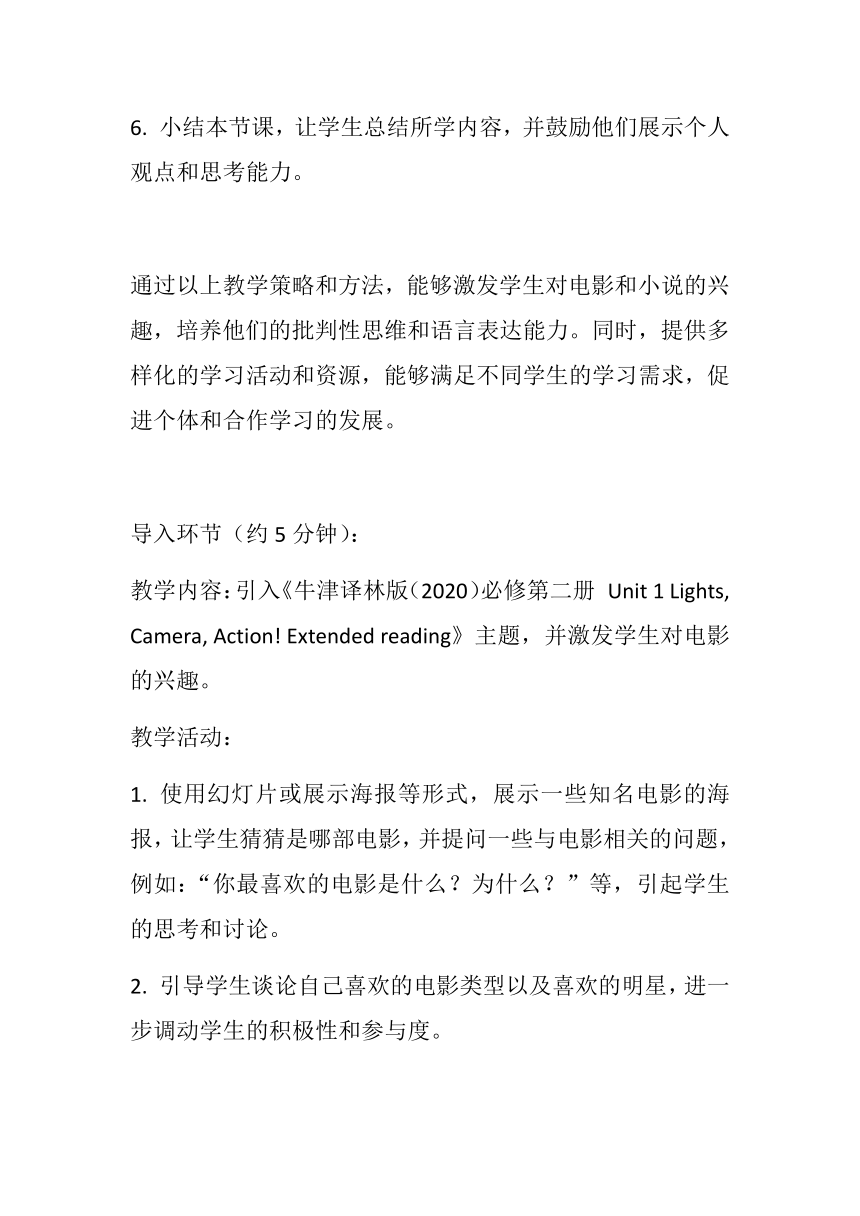牛津译林版(2019)必修 第二册Unit 1 Lights,camera,action! Extended reading教学设计
文档属性
| 名称 | 牛津译林版(2019)必修 第二册Unit 1 Lights,camera,action! Extended reading教学设计 |  | |
| 格式 | docx | ||
| 文件大小 | 21.0KB | ||
| 资源类型 | 教案 | ||
| 版本资源 | 牛津译林版(2019) | ||
| 科目 | 英语 | ||
| 更新时间 | 2023-11-03 12:41:11 | ||
图片预览





文档简介
牛津译林版(2020)必修第二册 Unit 1 Lights,Camera,Action!
Extended reading
教材分析:《牛津译林版(2020)必修第二册 Unit 1 Lights, Camera, Action! Extended Reading》是高中英语教材中的一篇阅读材料。该课文以《追风筝的人》为例,介绍了电影和小说之间的关系,并讨论了电影对观众的影响。
教学目标:通过本节课的学习,学生应能够了解电影和小说之间的联系与区别,理解电影在传达情感和思想方面的重要性,并能够分析和讨论电影对观众产生的影响。
教学重点:电影与小说之间的关系,电影对观众的影响。
教学难点:如何分析和讨论电影对观众的影响。
学情分析:学生是高一年级的学生,已经有一定的英语基础。他们对电影和小说都比较熟悉,但可能对电影与小说之间的关系和电影对观众的影响了解不深。此外,学生在语言表达和批判性思维方面还有待提高。
教学策略:通过提供相关背景知识、讨论和分析案例的方式,激发学生的兴趣和思考能力。
教学方法:任务型教学、合作学习、多媒体辅助教学。
在教学过程中,可以采用以下步骤:
1. 导入新课,介绍课文背景,引发学生对电影与小说的思考和讨论。
2. 让学生阅读课文,并带领学生一起回答相关问题,帮助学生理解电影和小说之间的联系和区别。
3. 组织学生进行小组讨论,让他们分享自己对电影的看法和观点,同时引导他们思考电影对观众的影响。
4. 引导学生分析并讨论电影中的情感和思想表达方式,以及观众对电影的不同反应。
5. 结合多媒体资源,播放相关电影或电影片段,让学生通过观察和讨论来进一步理解电影的影响力。
6. 小结本节课,让学生总结所学内容,并鼓励他们展示个人观点和思考能力。
通过以上教学策略和方法,能够激发学生对电影和小说的兴趣,培养他们的批判性思维和语言表达能力。同时,提供多样化的学习活动和资源,能够满足不同学生的学习需求,促进个体和合作学习的发展。
导入环节(约5分钟):
教学内容:引入《牛津译林版(2020)必修第二册 Unit 1 Lights, Camera, Action! Extended reading》主题,并激发学生对电影的兴趣。
教学活动:
1. 使用幻灯片或展示海报等形式,展示一些知名电影的海报,让学生猜猜是哪部电影,并提问一些与电影相关的问题,例如:“你最喜欢的电影是什么?为什么?”等,引起学生的思考和讨论。
2. 引导学生谈论自己喜欢的电影类型以及喜欢的明星,进一步调动学生的积极性和参与度。
课堂互动(约35分钟):
教学内容:通过阅读《牛津译林版(2020)必修第二册 Unit 1 Lights, Camera, Action! Extended reading》中的文章,让学生了解电影的历史和电影工业的发展。
教学活动:
1. 分组阅读:将学生分成小组,每个小组成员轮流阅读文章并回答相关问题。教师可以在组内引导学生讨论,分享自己的理解和观点,以促进学生之间的互动和合作。
2. 呈现理解:提问学生关于电影时代背景、电影工业的影响等问题,激发学生思考并准备发言。鼓励学生以语言的形式表达自己的观点,并与同学进行交流和辩论,培养学生的思辨能力和口语表达能力。
3. 观看相关视频:为了更好地了解电影的发展,教师可以选择一些与电影历史相关的视频片段,和学生一起观看并展开讨论,帮助学生深入理解电影的变迁和影响。
结束环节(约5分钟):
教学内容:总结本节课的重点内容,并展示学生的学习成果。
教学活动:
1. 总结提问:教师提出几个与本节课重点内容相关的问题,让学生回答并进行讨论。
2. 展示学习成果:请几个学生分享他们对电影历史和电影工业发展的理解和观点。教师可以提供一些肯定性的评价和指导性的建议,鼓励学生继续努力。
3. 布置作业:根据课堂学习的内容,布置一份以写作或讨论为主的作业,鼓励学生进一步思考和整理自己的观点。
通过以上教学过程的设计,可以激发学生的学习兴趣,提高学生的阅读理解能力和参与度,同时培养学生的合作能力和思辨能力。
课堂练习题:
1. 阅读下面的短文,选择正确的答案。
Film making is a complex process involving many different skills and talents. The first step in making a film is to come up with a good idea for a story. The story should be interesting and have a clear beginning, middle and end. After that, a scriptwriter writes the script. The script is like a detailed plan of the film. It contains all the dialogues, actions and camera angles. Once the script is ready, the producer starts looking for actors and actresses to play the characters. The casting director helps the producer find the right actors and actresses for the film. After the actors and actresses are chosen, the director starts working on the film. The director's job is to bring the story to life. The director decides how each scene should be filmed and tells the actors and actresses what to do. When the filming is finished, the editor puts all the scenes together to make the final film. The editor will choose the best shots for each scene and also add special effects if needed. Finally, the film is ready to be shown to the audience. It will be screened in movie theaters or made available for people to watch at home.
What is the script
A. The story of the film.
B. The detailed plan of the film.
C. The final film to be shown to the audience.
答案: B
解析: 文中提到"The script is like a detailed plan of the film. It contains all the dialogues, actions and camera angles."(剧本就像是电影的详细计划,它包含了所有的对话、动作和摄像机角度。)因此答案选B。
2. 根据短文的内容,判断下列句子是对还是错。
The producer is responsible for finding the right actors and actresses for the film.
答案: 对
解析: 文中提到"After that, a scriptwriter writes the script. The script is like a detailed plan of the film. It contains all the dialogues, actions and camera angles. Once the script is ready, the producer starts looking for actors and actresses to play the characters."(在那之后,编剧写剧本。剧本就像是电影的详细计划,它包含了所有的对话、动作和摄像机角度。一旦剧本准备好,制片人就开始寻找适合扮演角色的男演员和女演员。)因此判断句子是对的。
3. According to the passage, which of the following is NOT a part of filmmaking process
A. Writing the script.
B. Finding the right actors and actresses.
C. Editing the film.
答案: C
解析: 文中提到"The first step in making a film is to come up with a good idea for a story. The story should be interesting and have a clear beginning, middle and end. After that, a scriptwriter writes the script. The script is like a detailed plan of the film. It contains all the dialogues, actions and camera angles. Once the script is ready, the producer starts looking for actors and actresses to play the characters. The casting director helps the producer find the right actors and actresses for the film. After the actors and actresses are chosen, the director starts working on the film."(制作电影的第一步是想出一个好的故事创意。这个故事应该有趣,并且有一个明确的开头、中间和结尾。在那之后,编剧写剧本。剧本就像是电影的详细计划,它包含了所有的对话、动作和摄像机角度。一旦剧本准备好,制片人就开始寻找适合扮演角色的男演员和女演员。演员的选择由电影的导演负责。)因此答案选C,剪辑电影并不是制作电影的步骤之一。
教学反思:
在这节课中,我以牛津译林版(2020)必修第二册 Unit 1 Lights, Camera, Action! Extended reading主题进行了教学。通过课堂练习的设计,我发现学生对于电影制作的过程理解较为深刻,答题情况良好。
然而,在教学中,我也发现了一些问题。首先,我没有足够地引导学生去思考和讨论,大部分时间都是我在进行讲解。这导致了学生的参与度不高,他们的思维能力和批判性思维能力得不到充分发展。其次,我在教学中缺乏充分的多媒体资料的应用,这对于学生的视觉和听觉感受有一定的影响。
为了改进这些问题,我计划在下一节课的教学中做出以下改进。首先,我将采用更多的激发学生思考的教学方法,如提问、小组讨论、案例分析等,以培养学生的思辨能力和合作能力。其次,我将寻找更多的多媒体资源来支持我的教学,例如相关的视频片段、照片和音频材料,以提高学生的学习兴趣和理解能力。
总结起来,在这节课的教学中,我学到了提问和引导学生思考的重要性,以及多媒体资源的重要性。这些经验将对我今后的教学有很大的帮助。我也意识到我需要继续努力改进自己的教学方法,以更好地促进学生的学习和发展。
Extended reading
教材分析:《牛津译林版(2020)必修第二册 Unit 1 Lights, Camera, Action! Extended Reading》是高中英语教材中的一篇阅读材料。该课文以《追风筝的人》为例,介绍了电影和小说之间的关系,并讨论了电影对观众的影响。
教学目标:通过本节课的学习,学生应能够了解电影和小说之间的联系与区别,理解电影在传达情感和思想方面的重要性,并能够分析和讨论电影对观众产生的影响。
教学重点:电影与小说之间的关系,电影对观众的影响。
教学难点:如何分析和讨论电影对观众的影响。
学情分析:学生是高一年级的学生,已经有一定的英语基础。他们对电影和小说都比较熟悉,但可能对电影与小说之间的关系和电影对观众的影响了解不深。此外,学生在语言表达和批判性思维方面还有待提高。
教学策略:通过提供相关背景知识、讨论和分析案例的方式,激发学生的兴趣和思考能力。
教学方法:任务型教学、合作学习、多媒体辅助教学。
在教学过程中,可以采用以下步骤:
1. 导入新课,介绍课文背景,引发学生对电影与小说的思考和讨论。
2. 让学生阅读课文,并带领学生一起回答相关问题,帮助学生理解电影和小说之间的联系和区别。
3. 组织学生进行小组讨论,让他们分享自己对电影的看法和观点,同时引导他们思考电影对观众的影响。
4. 引导学生分析并讨论电影中的情感和思想表达方式,以及观众对电影的不同反应。
5. 结合多媒体资源,播放相关电影或电影片段,让学生通过观察和讨论来进一步理解电影的影响力。
6. 小结本节课,让学生总结所学内容,并鼓励他们展示个人观点和思考能力。
通过以上教学策略和方法,能够激发学生对电影和小说的兴趣,培养他们的批判性思维和语言表达能力。同时,提供多样化的学习活动和资源,能够满足不同学生的学习需求,促进个体和合作学习的发展。
导入环节(约5分钟):
教学内容:引入《牛津译林版(2020)必修第二册 Unit 1 Lights, Camera, Action! Extended reading》主题,并激发学生对电影的兴趣。
教学活动:
1. 使用幻灯片或展示海报等形式,展示一些知名电影的海报,让学生猜猜是哪部电影,并提问一些与电影相关的问题,例如:“你最喜欢的电影是什么?为什么?”等,引起学生的思考和讨论。
2. 引导学生谈论自己喜欢的电影类型以及喜欢的明星,进一步调动学生的积极性和参与度。
课堂互动(约35分钟):
教学内容:通过阅读《牛津译林版(2020)必修第二册 Unit 1 Lights, Camera, Action! Extended reading》中的文章,让学生了解电影的历史和电影工业的发展。
教学活动:
1. 分组阅读:将学生分成小组,每个小组成员轮流阅读文章并回答相关问题。教师可以在组内引导学生讨论,分享自己的理解和观点,以促进学生之间的互动和合作。
2. 呈现理解:提问学生关于电影时代背景、电影工业的影响等问题,激发学生思考并准备发言。鼓励学生以语言的形式表达自己的观点,并与同学进行交流和辩论,培养学生的思辨能力和口语表达能力。
3. 观看相关视频:为了更好地了解电影的发展,教师可以选择一些与电影历史相关的视频片段,和学生一起观看并展开讨论,帮助学生深入理解电影的变迁和影响。
结束环节(约5分钟):
教学内容:总结本节课的重点内容,并展示学生的学习成果。
教学活动:
1. 总结提问:教师提出几个与本节课重点内容相关的问题,让学生回答并进行讨论。
2. 展示学习成果:请几个学生分享他们对电影历史和电影工业发展的理解和观点。教师可以提供一些肯定性的评价和指导性的建议,鼓励学生继续努力。
3. 布置作业:根据课堂学习的内容,布置一份以写作或讨论为主的作业,鼓励学生进一步思考和整理自己的观点。
通过以上教学过程的设计,可以激发学生的学习兴趣,提高学生的阅读理解能力和参与度,同时培养学生的合作能力和思辨能力。
课堂练习题:
1. 阅读下面的短文,选择正确的答案。
Film making is a complex process involving many different skills and talents. The first step in making a film is to come up with a good idea for a story. The story should be interesting and have a clear beginning, middle and end. After that, a scriptwriter writes the script. The script is like a detailed plan of the film. It contains all the dialogues, actions and camera angles. Once the script is ready, the producer starts looking for actors and actresses to play the characters. The casting director helps the producer find the right actors and actresses for the film. After the actors and actresses are chosen, the director starts working on the film. The director's job is to bring the story to life. The director decides how each scene should be filmed and tells the actors and actresses what to do. When the filming is finished, the editor puts all the scenes together to make the final film. The editor will choose the best shots for each scene and also add special effects if needed. Finally, the film is ready to be shown to the audience. It will be screened in movie theaters or made available for people to watch at home.
What is the script
A. The story of the film.
B. The detailed plan of the film.
C. The final film to be shown to the audience.
答案: B
解析: 文中提到"The script is like a detailed plan of the film. It contains all the dialogues, actions and camera angles."(剧本就像是电影的详细计划,它包含了所有的对话、动作和摄像机角度。)因此答案选B。
2. 根据短文的内容,判断下列句子是对还是错。
The producer is responsible for finding the right actors and actresses for the film.
答案: 对
解析: 文中提到"After that, a scriptwriter writes the script. The script is like a detailed plan of the film. It contains all the dialogues, actions and camera angles. Once the script is ready, the producer starts looking for actors and actresses to play the characters."(在那之后,编剧写剧本。剧本就像是电影的详细计划,它包含了所有的对话、动作和摄像机角度。一旦剧本准备好,制片人就开始寻找适合扮演角色的男演员和女演员。)因此判断句子是对的。
3. According to the passage, which of the following is NOT a part of filmmaking process
A. Writing the script.
B. Finding the right actors and actresses.
C. Editing the film.
答案: C
解析: 文中提到"The first step in making a film is to come up with a good idea for a story. The story should be interesting and have a clear beginning, middle and end. After that, a scriptwriter writes the script. The script is like a detailed plan of the film. It contains all the dialogues, actions and camera angles. Once the script is ready, the producer starts looking for actors and actresses to play the characters. The casting director helps the producer find the right actors and actresses for the film. After the actors and actresses are chosen, the director starts working on the film."(制作电影的第一步是想出一个好的故事创意。这个故事应该有趣,并且有一个明确的开头、中间和结尾。在那之后,编剧写剧本。剧本就像是电影的详细计划,它包含了所有的对话、动作和摄像机角度。一旦剧本准备好,制片人就开始寻找适合扮演角色的男演员和女演员。演员的选择由电影的导演负责。)因此答案选C,剪辑电影并不是制作电影的步骤之一。
教学反思:
在这节课中,我以牛津译林版(2020)必修第二册 Unit 1 Lights, Camera, Action! Extended reading主题进行了教学。通过课堂练习的设计,我发现学生对于电影制作的过程理解较为深刻,答题情况良好。
然而,在教学中,我也发现了一些问题。首先,我没有足够地引导学生去思考和讨论,大部分时间都是我在进行讲解。这导致了学生的参与度不高,他们的思维能力和批判性思维能力得不到充分发展。其次,我在教学中缺乏充分的多媒体资料的应用,这对于学生的视觉和听觉感受有一定的影响。
为了改进这些问题,我计划在下一节课的教学中做出以下改进。首先,我将采用更多的激发学生思考的教学方法,如提问、小组讨论、案例分析等,以培养学生的思辨能力和合作能力。其次,我将寻找更多的多媒体资源来支持我的教学,例如相关的视频片段、照片和音频材料,以提高学生的学习兴趣和理解能力。
总结起来,在这节课的教学中,我学到了提问和引导学生思考的重要性,以及多媒体资源的重要性。这些经验将对我今后的教学有很大的帮助。我也意识到我需要继续努力改进自己的教学方法,以更好地促进学生的学习和发展。
